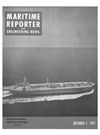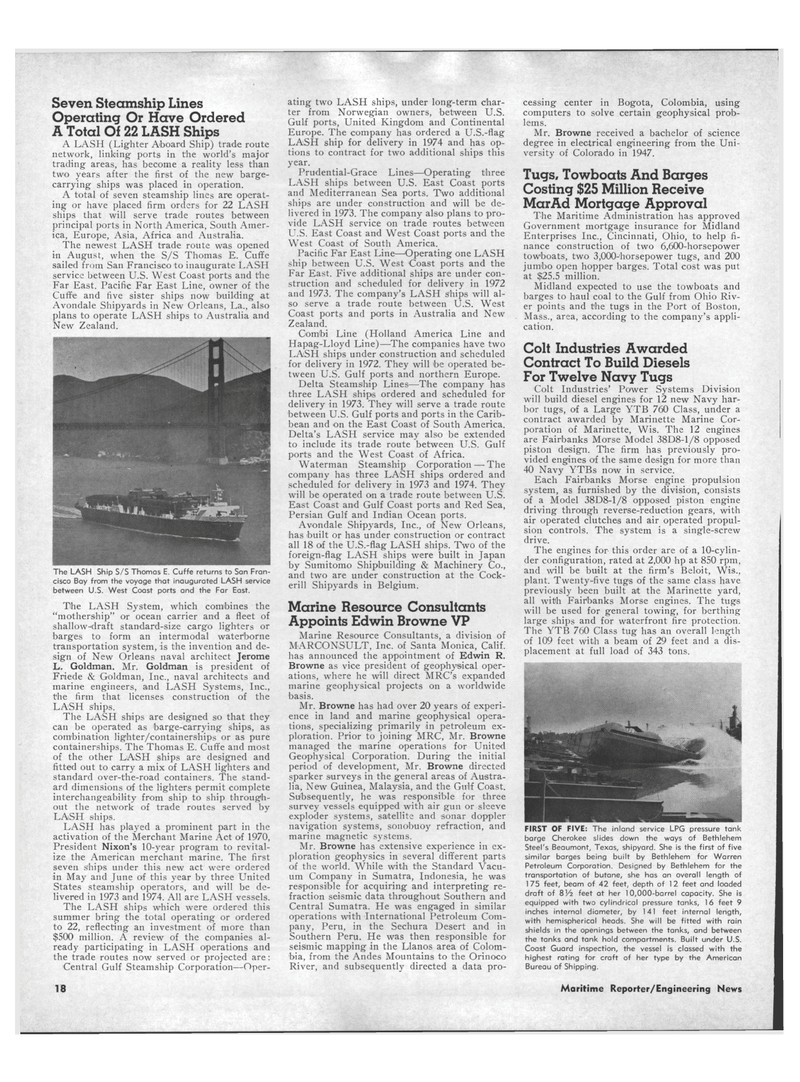
Page 16: of Maritime Reporter Magazine (October 1971)
Read this page in Pdf, Flash or Html5 edition of October 1971 Maritime Reporter Magazine
Seven Steamship Lines
Operating Or Have Ordered
A Total Of 22 LASH Ships
A LASH (Lighter Aboard Ship) trade route network, linking ports in the world's major trading areas, has become a reality less than two years after the first of the new barge- carrying ships was placed in operation.
A total of seven steamship lines are operat- ing or have placed firm orders for 22 LASH ships that will serve trade routes between principal ports in North America, South Amer- ica, Europe, Asia, Africa and Australia.
The newest LASH trade route was opened in August, when the S/S Thomas E. Cuffe sailed from San Francisco to inaugurate LASH service between U.S. West Coast ports and the
Far East. Pacific Far East Line, owner of the
Cuffe and five sister ships now building at
Avondale Shipyards in New Orleans, La., also plans to operate LASH ships to Australia and
New Zealand.
The LASH Ship S/S Thomas E. Cuffe returns to San Fran- cisco Bay from the voyage that inaugurated LASH service between U.S. West Coast ports and the Far East.
The LASH System, which combines the "mothership" or ocean carrier and a fleet of shallowjdraft standard-size cargo lighters or barges to form an intermodal waterborne transportation system, is the invention and de- sign of New Orleans naval architect Jerome
L. Goldman. Mr. Goldman is president of
Friede & Goldman, Inc., naval architects and marine engineers, and LASH Systems, Inc., the firm that licenses construction of the
LASH ships.
The LASH ships are designed so that they can be operated as barge-carrying ships, as combination lighter/containerships or as pure containerships. The Thomas E. Cuffe and most of the other LASH ships are designed and fitted out to carry a mix of LASH lighters and standard over-the-road containers. The stand- ard dimensions of the lighters permit complete interchangeability from ship to ship through- out the network of trade routes served by
LASH ships.
LASH has played a prominent part in the activation of the Merchant Marine Act of 1970,
President Nixon's 10-year program to revital- ize the American merchant marine. The first seven s'hips under this new act were ordered in May and June of this year by three United
States steamship operators, and will be de- livered in 1973 and 1974. All are LASH vessels.
The LASH ships which were ordered this summer bring the total operating or ordered to 22, reflecting an investment of more than $500 million. A review of the companies al- ready participating in LASH operations and the trade routes now served or projected are:
Central Gulf Steamship Corporation—Oper- ating two LASH ships, under long-term char- ter from Norwegian owners, between U.S.
GuLf ports, United Kingdom and Continental
Europe. The company has ordered a U.S.-flag
LASH ship for delivery in 1974 and has op- tions to contract for two additional ships this year.
Prudential-Grace Lines—Operating three
LASH ships between U.S. East Coast ports and Mediterranean Sea ports. Two additional ships are under construction and will be de- livered in 1973. The company also plans to pro- vide LASH service on trade routes between
U.S. East Coast and West Coast ports and the
West Coast of South America.
Pacific Far East Line—Operating one LASH ship between U.S. West Coast ports and the
Far East. Five additional ships are under con- struction and scheduled for delivery in 1972 and 1973. The company's LASH ships will al- so serve a trade route between U.S. West
Coast ports and ports in Australia and New
Zealand.
Gombi Line (Holland America Line and
Hapag-Lloyd Line)—The companies have two
LASH ships under construction and scheduled for delivery in 1972. They will be operated be- tween U.S. Gulf ports and northern Europe.
Delta Steamship Lines—The company has three LASH ships ordered and scheduled for delivery in 1973. They will serve a trade route between U.S. Gulf ports and ports in the Carib- bean and on the East Coast of South America.
Delta's LASH service may also be extended to include its trade route between U.S. Gulf ports and the West Coast of Africa.
Waterman Steamship Corporation — The company has three LASH ships ordered and scheduled for delivery in 1973 and 1974. They will be operated on a trade route between U.S.
East Coast and Gulf Coast ports and Red Sea,
Persian Gulf and Indian Ocean ports.
Avondale Shipyards, Inc., of New Orleans, has built or has under construction or contract all 18 of the U.S.-flag LASH ships. Two of the foreign-flag LASH ships were built in Japan by Sumitomo Shipbuilding & Machinery Co., and two are under construction at the Cock- erill Shipyards in Belgium.
Marine Resource Consultants
Appoints Edwin Browne VP
Marine Resource Consultants, a division of
MARCONSULT, Inc. of Santa Monica, Calif, has announced the appointment of Edwin R.
Browne as vice president of geophysical oper- ations, where he will direct MRC's expanded marine geophysical projects on a worldwide basis.
Mr. Browne has had over 20 years of experi- ence in land and marine geophysical opera- tions, specializing primarily in petroleum ex- ploration. Prior to joining MRC, Mr. Browne managed the marine operations for United
Geophysical Corporation. During the initial period of development, Mr. Browne directed sparker surveys in the general areas of Austra- lia, New Guinea, Malaysia, and the Gulf Coast.
Subsequently, he was responsible for three survey vessels equipped with air gun or sleeve exploder systems, satellite and sonar doppler navigation systems, sonobuoy refraction, and marine magnetic systems.
Mr. Browne has extensive experience in ex- ploration geophysics in several different parts of the world. While with the Standard Vacu- um Company in Sumatra, Indonesia, he was responsible for acquiring and interpreting re- fraction seismic data throughout Southern and
Central Sumatra. He was engaged in similar operations with International Petroleum Com- pany, Peru, in the Sechura Desert and in
Southern Peru. He was then responsible for seismic mapping in the Llanos area of Colom- bia, from the Andes Mountains to the Orinoco
River, and subsequently directed a data pro- cessing center in Bogota, Colombia, using computers to solve certain geophysical prob- lems.
Mr. Browne received a bachelor of science degree in electrical engineering from the Uni- versity of Colorado in 1947.
Tugs, Towboats And Barges
Costing $25 Million Receive
MarAd Mortgage Approval
The Maritime Administration has approved
Government mortgage insurance for Midland
Enterprises Inc., Cincinnati, Ohio, to help fi- nance construction of two 6,600-horsepower towboats, two 3,000-horsepower tugs, and 200 jumbo open hopper barges. Total cost was put at $25.5 million.
Midland expected to use the towboats and barges to haul coal to the Gulf from Ohio Riv- er points and the tugs in the Port of Boston,
Mass., area, according to the company's appli- cation.
Colt Industries Awarded
Contract To Build Diesels
For Twelve Navy Tugs
Colt Industries' Power Systems Division will build diesel engines for 12 new Navy har- bor tugs, of a Large YTB 760 Class, under a contract awarded by Marinette Marine Cor- poration of Marinette, Wis. The 12 engines are Fairbanks Morse Model 38D8-1/8 opposed piston design. The firm has previously pro- vided engines of the same design for more than 40 Navy YTBs now in service.
Each Fairbanks Morse engine propulsion system, as furnished by the division, consists of a Model 38D8-1/8 opposed piston engine driving through reverse-reduction gears, with air operated clutches and air operated propul- sion controls. The system is a single-screw drive.
The engines for this order are of a 10-cylin- der configuration, rated at 2,000 hp at 850 rpm, and will be built at the firm's Beloit, Wis., plant. Twenty-five tugs of the same class have previously been built at the Marinette yard, all with Fairbanks Morse engines. The tugs will be used for general towing, for berthing large ships and for waterfront fire protection.
The YTB 760 Class tug has an overall length of 109 feet with a beam of 29 feet and a dis- placement at full load of 343 tons.
FIRST OF FIVE: The inland service LPG pressure tank barge Cherokee slides down the ways of Bethlehem
Steel's Beaumont, Texas, shipyard. She is the first of five similar barges being built by Bethlehem for Warren
Petroleum Corporation. Designed by Bethlehem for the transportation of butane, she has an overall length of 1 75 feet, beam of 42 feet, depth of 1 2 feet and loaded draft of 8V2 feet at her 10,000-barrel capacity. She is equipped with two cylindrical pressure tanks, 16 feet 9 inches internal diameter, by 141 feet internal length, with hemispherical heads. She will be fitted with rain shields in the openings between the tanks, and between the tanks and tank hold compartments. Built under U.S.
Coast Guard inspection, the vessel is classed with the highest rating for craft of her type by the American
Bureau of Shipping. 18 Maritime Reporter/Engineering News

 15
15

 17
17
